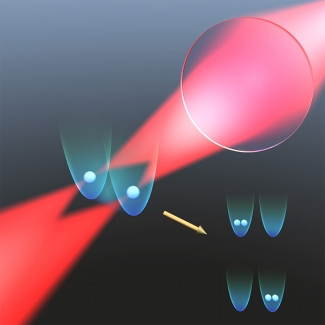Graduate student Adam Kaufman and his colleagues in the Regal and Rey groups have demonstrated a key first step in assembling quantum matter one atom at a time. Kaufman accomplished this feat by laser-cooling two atoms of rubidium (87Rb) trapped in separate laser beam traps called optical tweezers. Then, while maintaining complete control over the atoms to be sure they were identical in every way, he moved the optical tweezers closer and closer until they were about 600 nm apart. At this distance, the trapped atoms were close enough to “tunnel” their way over to the other laser beam trap if they were so inclined.
The researchers were curious to see what would happen next. After all, the individual atoms are so small that they actually can interfere like waves. On top of that, the 87Rb atoms were bosons. And, bosons are the kind of particle that can occupy exactly the same quantum state at ultralow temperatures and form a tiny Bose-Einstein condensate, or BEC.
Kaufman realized that his atoms might also interfere with each other—just like photons of light. That’s when things got really interesting. Photons, which are also bosons, interfere with one another in a very peculiar way when there are only two of them. Kaufman wanted to find out if his 87Rb atoms would behave in the same way.
A few milliseconds into the experiment, Kaufman observed that even though the two atoms started out trapped in different optical tweezers, they both turned up in either one or the other optical tweezers when he “looked” to see where they were. He also discovered that it was impossible to predict ahead of time which laser-beam trap would get the two atoms.
Interestingly, he almost never found the two atoms in separate optical tweezers. He knew that waves sometimes cancel each other out—if their crests and troughs line up with each other. Similarly, the possibility of finding one atom in each tweezer disappeared during the experiment—because of destructive interference of the matter waves of the two bosons. Kaufman and his colleagues showed that this is exactly what happened.
Kaufman also showed that exquisite control of the atoms was required to see the destructive interference; any misstep that allowed someone to tell the difference between the two atoms also destroyed the effect. Hence, the experiment showed that Kaufman is very good at assembling single cold atoms into a tiny two-atom quantum structure. This achievement will likely have profound consequences.
First, this experiment is the first step in engineering a brand new quantum system. It may well open the door to systematically using single-trapped atoms to assemble BECs or other quantum systems. Such designer quantum systems have very exciting future prospects, including highly sensitive nanoscale force detection, tiny optical devices based on the control of neutral atoms, and quantum simulators based on laser-cooled atoms in arrays of optical tweezers.
The little shop of atoms invented by Kaufman and his colleagues is now open for business. Kaufman’s experimentalist colleagues in this venture include graduate students Brian Lester and Collin Reynolds as well as Fellow Cindy Regal. Their theorist colleagues include research associate Michael Wall, former graduate student Michael Foss-Feig, senior research associate Kaden Hazzard, and Fellow Ana Maria Rey.—Julie Phillips and Cindy Regal




